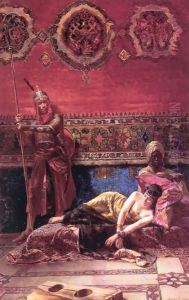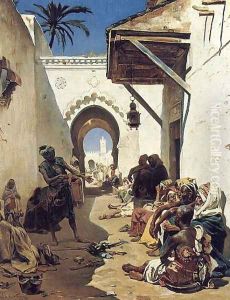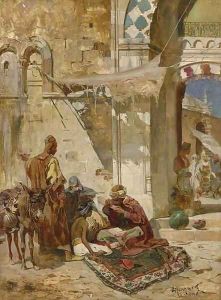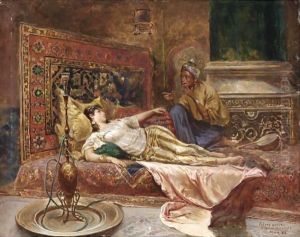Ferencz-Franz Eisenhut Paintings
Ferencz-Franz Eisenhut was a distinguished Hungarian painter known for his Orientalist themes and historical scenes, born in 1857 in Baja, then part of the Austrian Empire (present-day Hungary). Eisenhut demonstrated an early talent for art, which led him to pursue formal education in the field. He studied at the Academy of Fine Arts Vienna under the guidance of notable instructors such as Christian Griepenkerl and Carl Wurzinger. His education further extended to Munich, a major art hub of the time, where he was influenced by the works of other Orientalist painters and the academic style prevalent in the late 19th century.
Eisenhut's work is characterized by meticulous attention to detail, vibrant coloration, and a fascination with the exoticism of the Eastern world. He traveled extensively in the Middle East, including Egypt and Palestine, drawing inspiration from the landscapes, people, and cultures he encountered. These travels significantly influenced his artistic output, leading to the creation of works that not only captured the visual allure of the Orient but also attempted to convey its cultural richness.
Among his notable works are dramatic scenes of historical and biblical events, which were praised for their realism and emotional intensity. Eisenhut's paintings were well-received in his time, earning him accolades and recognition. He exhibited his works in various cities across Europe, including Vienna, Munich, and Budapest, contributing to the popularization of Orientalist art within the continent.
Despite his success, Ferencz-Franz Eisenhut's life was relatively short; he died in 1903 at the age of 46. His legacy, however, endures through his contributions to the Orientalist movement in European art. Eisenhut's body of work remains an important subject of study for art historians and a source of inspiration for artists interested in the intersection between European art and the cultures of the Middle East and North Africa. His paintings continue to be celebrated for their intricate detail, historical accuracy, and the unique perspective they offer on the regions depicted.



